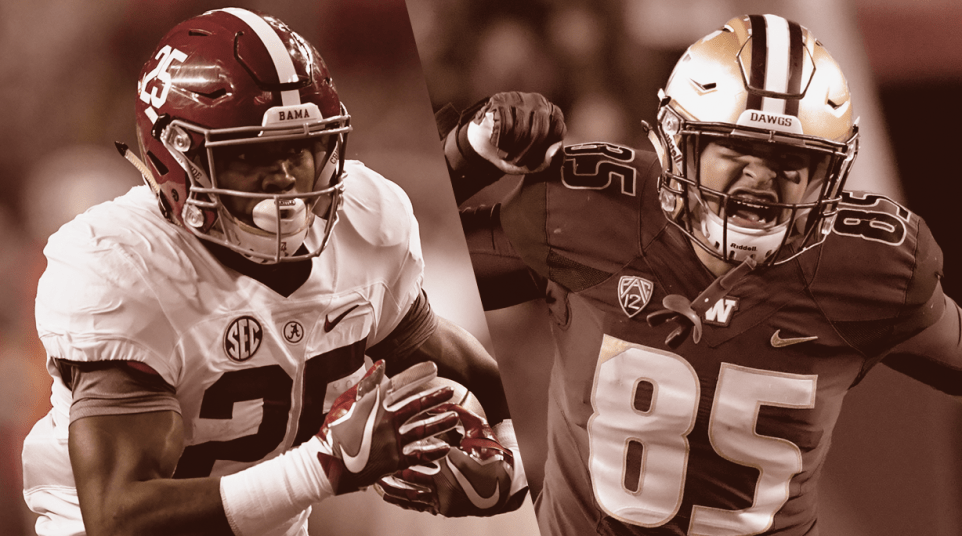The Big Peach Bowl Preview: Don't Expect Another Bama Blowout
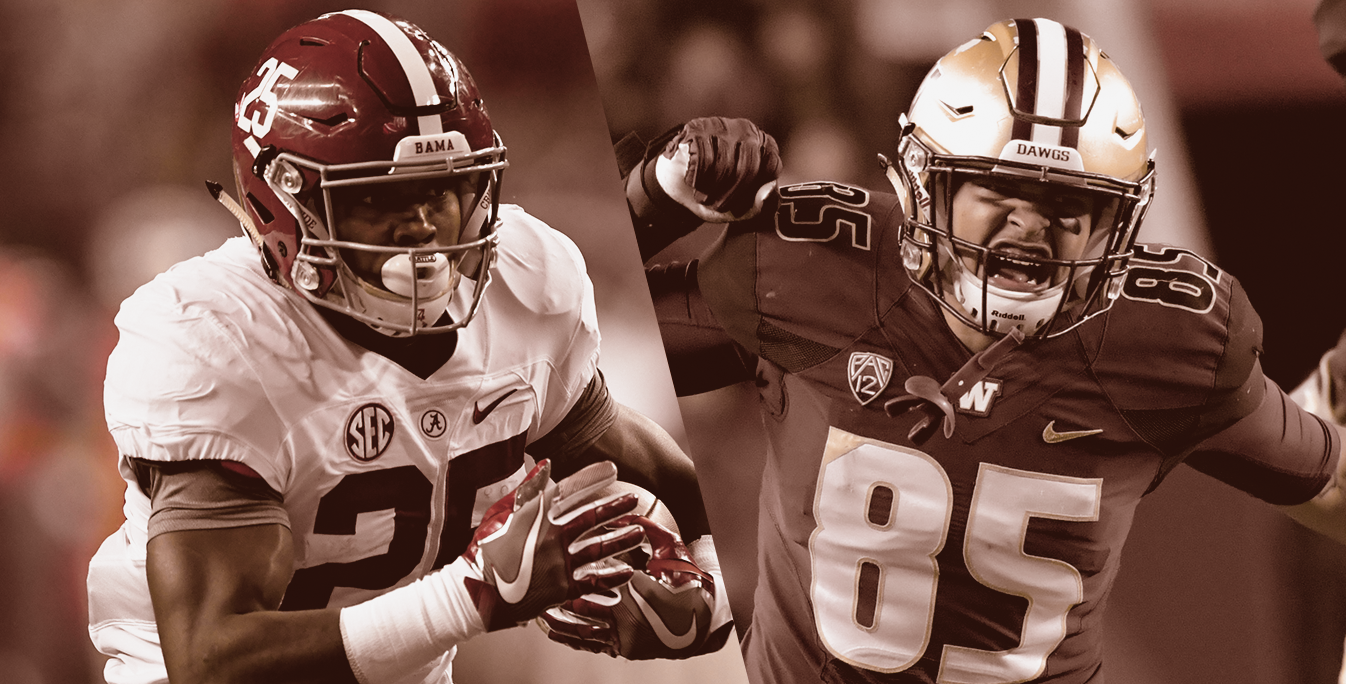
The Big Peach Bowl Preview: Don’t Expect Another Bama Blowout
Before we dive into the details of Saturday’s semifinal collision between Alabama and Washington, let’s dispense with a few pleasantries. In Vegas, the Crimson Tide have held steady as 14-points favorites, a huge spread for two ostensible contenders — Bama was a 9.5-point favorite in last year’s semifinal date with Michigan State, for example, a game virtually no one gave the Spartans a chance to win — and also a reasonable one. We’ve been here before, and we know what it tends to look like. Alabama has dominated so many big, winner-take-all games under Nick Saban to such a grisly degree that the prospect of a mere two-touchdown victory almost seems charitable.
Already this year the Tide have dispatched eight ranked-at-the-time opponents by an average margin of 24 points. They’ve gone wire-to-wire at the top of both major polls, a rare feat that puts them in the running to be remembered as one of the greatest college teams ever. Right from the start, their place in this game has felt like such a foregone conclusion that it’s almost as if their real season is just beginning.
So right up front, all you really want to know is: Does Washington stand a chance?
And the answer, obviously, is yes. Of course. The Huskies earned their ticket to the playoff as champions of a major conference that they won going away. Given the overall mediocrity of the SEC, they’ll also be the best team Alabama has played this year by some distance. Depending on which statistical model you ask, Washington has somewhere in the neighborhood of a 29 percent to 32 percent chance of springing the upset — not great, but an awfully long way from zero. Those are better odds than we saw in certain other recent victories in nationally relevant contests.
At this point, it’s as difficult as its ever been to pierce the Bama mystique. It might take a perfect game from the underdogs, and then maybe a couple of breaks on top of that. But when they’re on, the Huskies are as well-equipped to give the No. 1 team a run for its money as any outfit in the country, on both sides of the ball. Look closely enough, past the logos and the school colors, and it’s not difficult at all to see the outlines of a classic.
When Alabama Has the Ball
Generally speaking, the story of a team that settles on a true freshman quarterback in the season opener, revamps the offense in his image, and subsequently finishes the regular season without a 1,000-yard rusher or receiver is unlikely to end with said team breaking the school scoring record. Thirteen games in, though, the Crimson Tide remain on pace to do exactly that, having scored at least 30 points in every game but one (an old-school, 10-0 slugfest at LSU) and routinely flirted with 50 before calling off the dogs. In eight games against ranked-at-the-time opponents, Bama scored 48 or more in five of them.
That they managed to do that without the benefit of a true star is a testament to their balance and depth, and, yes, in part to a defense that contributed 10 touchdowns of its own to the cause. It’s also a testament to Lane Kiffin, whose scheme managed to incorporate significant roles for an assortment of very ambitious backs and receivers without overloading Jalen Hurts’ 18-year-old brain. Above all, it’s a reflection of the Tide’s consistency — the opening-day lineup remained intact throughout the season, and according to Bill Connelly’s S&P+ rating system Alabama’s offensive grade typically ranked in the 80th percentile or higher:
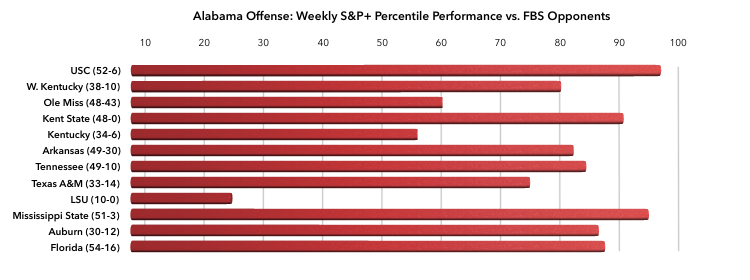
Granted, that level of week-in, week-out consistency is more of a luxury than a necessity opposite a defense that regularly graded out in the 90th percentile, as that glaring outlier in Baton Rouge proves. But this is a more versatile attack entering the semifinal round than it was either of the past two years, even without a veteran QB or an above-the-fold bellcow in the mold of Amari Cooper or Derrick Henry. Total yards, rushing yards and yards per play all improved relative to 2014-15, while pass efficiency was essentially flat.
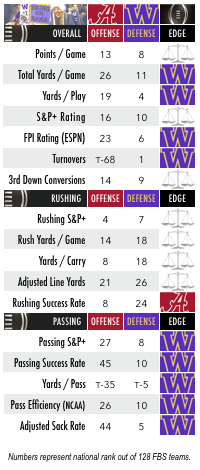 So there are no obvious weaknesses, just as you’d expect from a 13-0 outfit that hasn’t trailed in the fourth quarter of any game. On the other hand, compared to Washington’s defense the Crimson Tide don’t arrive with any dead obvious advantages, either. Statistically, the tale of the tape predicts a push on the ground — both teams finished in the mid-teens nationally in rushing offense/defense — and a narrow but distinct edge for Washington in the passing game. Personnel-wise, the Huskies boast a pair of all-conference picks with first-round potential on the defensive line (Elijah Qualls, Vita Vea) and in the secondary (Sidney Jones, Budda Baker), the latter of which is every bit the equal of Bama’s vaunted secondary in the eyes of pro scouts. And so far, at least, they’ve weathered season-ending injuries to linebackers Joe Mathis and Azeem Victor without any discernible decline down the stretch. On the contrary: In its past two games, Washington held Washington State (with the Pac-12 North on the line) and Colorado (in the Pac-12 title game) to their worst output of the year.
So there are no obvious weaknesses, just as you’d expect from a 13-0 outfit that hasn’t trailed in the fourth quarter of any game. On the other hand, compared to Washington’s defense the Crimson Tide don’t arrive with any dead obvious advantages, either. Statistically, the tale of the tape predicts a push on the ground — both teams finished in the mid-teens nationally in rushing offense/defense — and a narrow but distinct edge for Washington in the passing game. Personnel-wise, the Huskies boast a pair of all-conference picks with first-round potential on the defensive line (Elijah Qualls, Vita Vea) and in the secondary (Sidney Jones, Budda Baker), the latter of which is every bit the equal of Bama’s vaunted secondary in the eyes of pro scouts. And so far, at least, they’ve weathered season-ending injuries to linebackers Joe Mathis and Azeem Victor without any discernible decline down the stretch. On the contrary: In its past two games, Washington held Washington State (with the Pac-12 North on the line) and Colorado (in the Pac-12 title game) to their worst output of the year.
The question of the week is how well — and how long — the Huskies’ interior trio of Qualls, Vea and Greg Gaines can hold up against an offensive line used to imposing its will on every defense in its path. It hasn’t always been the out-and-out stampede that the numbers suggest, but in the end the Crimson Tide have ground out 200-yard rushing games against USC (242), Ole Miss (334), Arkansas (264), Tennessee (409), Texas A&M (287), LSU (216), Auburn (203), and Florida (234), among others, and that’s after subtracting negative yardage on sacks. No other offense ran for more yards against Power 5 opponents.
To the their credit, the Huskies have been as good or better against the run than any of those teams, with the possible exception of LSU, and if they can force Alabama into obvious passing situations, the matchups are much more favorable for them in the pass rush and the secondary.
Washington led the nation in takeaways, and Hurts has hardly been immune to the occasional freshman lapse. He’s also an unknown commodity if he’s ever forced to abandon the usual script; even in Bama’s rally from a 24-3 deficit at Ole Miss, the comeback was fueled in large part by touchdowns on defense on special teams.
Poised as he may be, at no point has an opposing defense forced Hurts to stand in the pocket and consistently beat them as a conventional passer. As long as the Tide continue to average six yards per carry on first and second down, though, as they have all year, that scenario will remain strictly hypothetical.
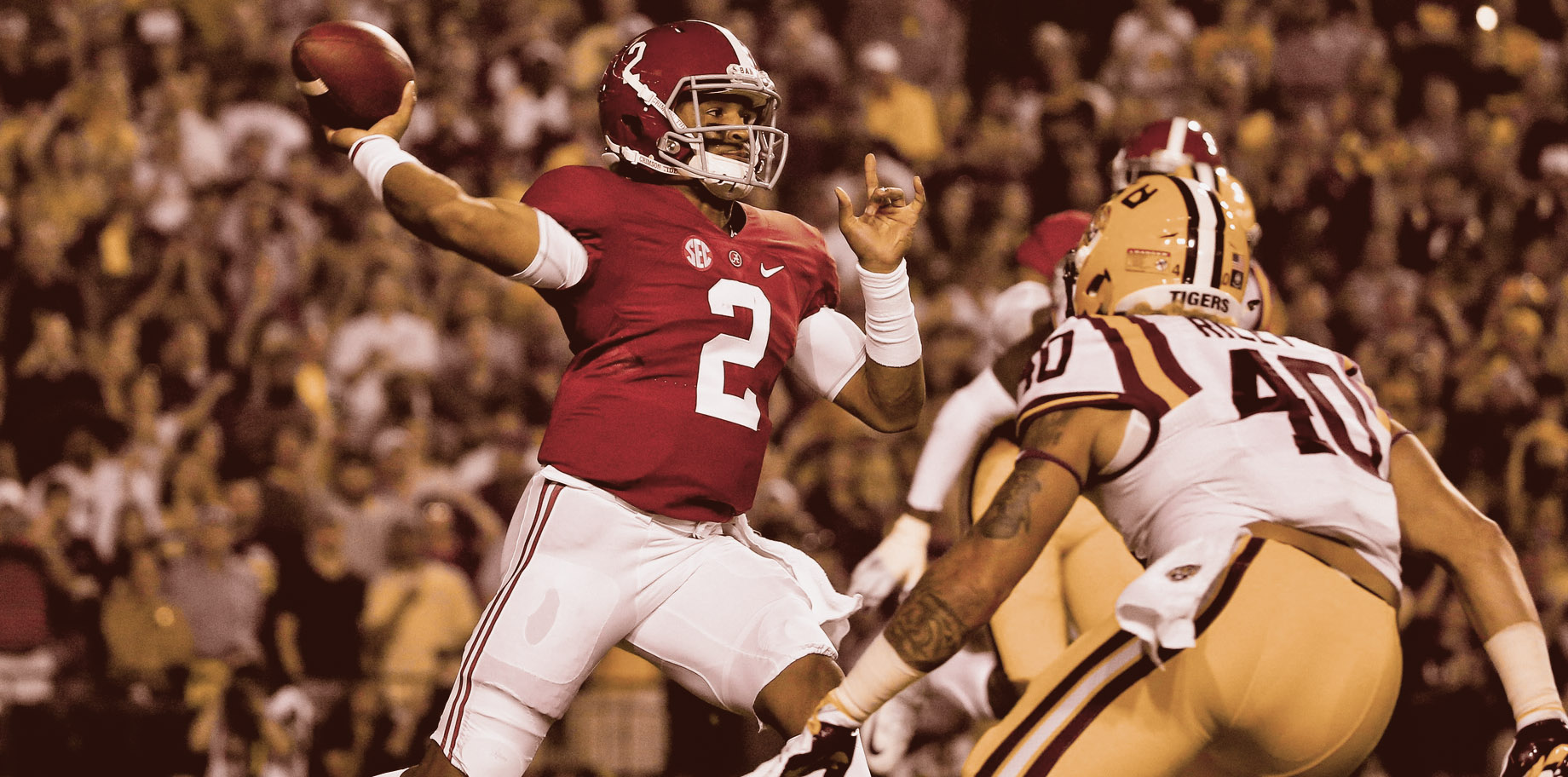
Key Matchup: Alabama TE O.J. Howard vs. Washington DB Budda Baker
At 5-foot-10, 192 pounds, Baker is a natural playmaker, a roving, Polamaluvian presence in the secondary who led U-Dub in solo tackles and TFLs despite frequently ranking as the smallest player on the field.
He broke up passes (5), picked off passes (2), manned up on slot receivers, blitzed from the nickel, featured prominently on goal-line stands … whatever there is to do on defense, short of filling in at nose tackle, he did it as well as anyone else the Huskies have, becoming a consensus All-American in the process.
Flip the conversation to offense, though, and much the same can be said for Howard, a utility tight end/wide receiver/H-back whose combination of freaky athleticism in a massive, 6-6, 250-pound frame makes him a matchup nightmare regardless of where he lines up, and regardless of who lines up across from him on defense.
Everyone remembers Howard’s MVP turn in last year’s championship game, which turned into an unlikely stage for his breakthrough as a receiver. In the meantime, he’s made quiet but steady progress this season as a blocker, playing an indispensable role in clearing the way for Bama’s read-option game outside the tackles.
If you made a list of college defenders with the talent and chops to take on Howard in both capacities, as a downfield receiver and a lead blocker in space, Baker probably comes in a close second to Michigan’s Jabrill Peppers. And if you designed a player in a laboratory specifically to exploit Baker’s limitations, Howard would supply the mold.
When Washington Has the Ball
On paper, Jake Browning is the best opposing passer the Crimson Tide have faced since Deshaun Watson carved them up in last year’s championship game, and it’s not close:
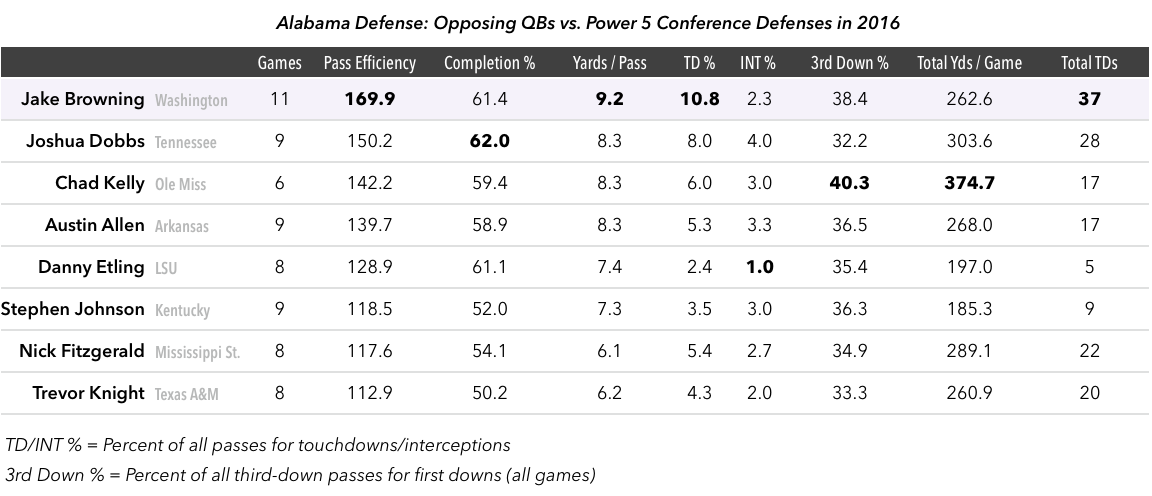
Note that Washington’s offense is a run-first scheme that (unlike, say, Ole Miss) generally doesn’t lend itself to gaudy, high-volume passing stats if you’re only looking at the total yardage. Still, among all Power 5 quarterbacks Browning ranked first in touchdown-to-interception ratio, second in overall efficiency, and third in yards per attempt, numbers that reside in a much ritzier statistical zip code than the other QBs on that list.
(Efficiency-wise, they also represent a significantly better stat line across the board than Watson brought into the 2015 title game.)
And although he’s only a sophomore — and although he checks in at just 6-1, 209 pounds, well below the usual NFL benchmark — when it’s all said and done Browning might be the only passer Bama’s blue-chip, farm-league defense has faced with a legitimate future at the next level in his own right. He finished sixth in the Heisman vote, and based strictly on the numbers he arguably should have come in higher.
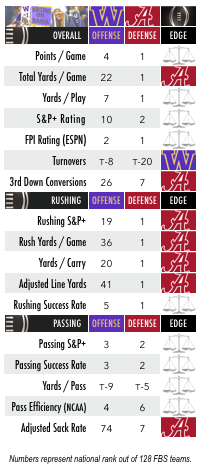 With Browning firmly entrenched behind center, the result was a balanced, big-play-oriented attack that easily led the Pac-12 in scoring offense, yards per play, and (in advanced-stat terms) both Offensive S&P+ and Offensive Efficiency, per ESPN’s Football Power Index. His top four receivers, John Ross III, Dante Pettis, Chico McClatcher, and tight end Darrell Daniels, came out of nowhere to haul in 39 touchdowns between them on 16.3 yards per catch, with Ross, in particular, emerging as one of the most lethal deep threats in the nation. Along with the thunder-and-lightning tailback combo of Myles Gaskin (1,339 yards, 10 TDs) and Lavon Coleman (836 yards, 7 TDs) on the ground, the Huskies boast legitimate big-play options at every skill position.
With Browning firmly entrenched behind center, the result was a balanced, big-play-oriented attack that easily led the Pac-12 in scoring offense, yards per play, and (in advanced-stat terms) both Offensive S&P+ and Offensive Efficiency, per ESPN’s Football Power Index. His top four receivers, John Ross III, Dante Pettis, Chico McClatcher, and tight end Darrell Daniels, came out of nowhere to haul in 39 touchdowns between them on 16.3 yards per catch, with Ross, in particular, emerging as one of the most lethal deep threats in the nation. Along with the thunder-and-lightning tailback combo of Myles Gaskin (1,339 yards, 10 TDs) and Lavon Coleman (836 yards, 7 TDs) on the ground, the Huskies boast legitimate big-play options at every skill position.
To which Bama fans, of course, will reply: So what? Passing and catching is one thing, but the big, make-or-break question for any offense that lines up across from the Tide is how those numbers will translate opposite their NFL-ready front seven, one of the most reliably dominant forces in college football in recent memory. The answer so far is, they break: Opposing offenses were 0-for-13 in the regular season attempting to establish the run and not much better through the air, save for a pair of 400-yard, three-touchdown passing days by Ole Miss and Arkansas.
Even in those games, their worst by far in terms of yards and points allowed, the Tide balanced the ledger against the Rebels and Razorbacks by forcing a combined seven takeaways and scoring three defensive TDs courtesy of a relentless pass rush.
That’s a major problem for Washington’s offensive line, which looks like the team’s weakest link (relatively speaking) after finishing 41st in Adjusted Line Yards and 74th in Adjusted Sack Rate. It’s no coincidence that Browning’s worst game as a passer coincided with an uncharacteristically dismal rushing effort against USC, which held Gaskin and Coleman to 57 yards on 3.4 per carry in the Huskies’ only loss.
In every other Pac-12 game, Washington piled up at least 175 yards on the ground en route to at least 31 points; without his usual run support against the Trojans, Browning was picked twice, sacked three times, and failed to lead a single sustained touchdown drive. (The Huskies’ only TD in that game came on an 80-yard bomb from Browning to Ross, evidence of how explosive that connection can be even when the offense as a whole is out of sync.)
Browning has been mostly fine against competent defenses, especially in the 44-6 romp over Stanford that announced Washington’s arrival as a national player. But if the ground game can’t keep Bama’s elite edge-rushing platoon honest, we know full well how the rest of that script unfolds.
Key Matchup: Washington LT Trey Adams vs. Alabama DL Jonathan Allen
The toughest individual assignment falls to Adams, a 6-foot-7, 309-pound sophomore who’s grown from true freshman starter in 2015 into a first-team All-Pac-12 pick with an NFL future. You know, eventually.
Against Allen, though — or Tim Williams, or Ryan Anderson, depending on Alabama’s alignment — he’ll be asked to protect Browing’s blind side from a guy who could hold his own in the NFL right now, a much steeper test than he’s faced to this point in his career.
The closest approximation to Allen out west is probably Stanford’s Solomon Thomas, another versatile, 3-4 end who was voted by opposing blockers as the best defensive lineman in the conference; head-to-head, Adams helped shut Thomas out back in September, holding him (along with the rest of Stanford’s front seven) without a sack, QB hurry, or tackle for loss in the Huskies’ most physically dominant outing.
There’s no shutout in the cards against Alabama: The Crimson Tide recorded at least five TFLs in every game, and at least three sacks in all but two. Allen personally made his mark in the box score on a weekly basis. Still, if Adams and his line mates can limit the pressure to a handful of isolated incidents, as opposed to the no-holds-barred stampede that bludgeoned Michigan State into submission last year, then Browning and his receivers are good enough to inflict the kind of damage on Bama’s secondary that Ole Miss did early in the season.
If not, the massive point spread might wind up looking conservative. Again.
Special Teams, Turnovers, and Other Imponderables
Winning the kicking game is critical in winner-take-all situations, as Alabama knows well. But attempting to predict the impact of the kicking game is like trying to predict a lightning strike: The kind of big plays and crippling errors that stand to make a real difference are so irregular that they will always be unlikely to occur in any given game, even though they’re often devastating and decisive when they do.
One thing we can expect is a competent outing from the respective kickers, as long as they’re not asked to drive home field goals from NFL distances — for the season, Washington’s Cameron Van Winkle and Alabama’s Adam Griffith (of Kick Six fame) combined to hit 28 of 32 attempts from 39 yards in, but went just 7-of-14 from 40 and beyond. If there’s an edge in this category, it probably goes to Van Winkle, who’s been slightly more reliable than Griffith over the course of his career. But both are seniors with three years’ experience as the primary placekicker, and neither has ever shown enough consistency to be trusted from long range. Call it a wash.
The return game is tougher to gauge, especially for Alabama, which lost All-American punt returner Eddie Jackson to a broken leg in mid-October. Before the injury, Jackson housed a pair of punts against Ole Miss and Tennessee, as well as a pick-six against Western Kentucky that showed off the same dynamic return skills in the open field; since, freshman Trevon Diggs has yet to supply much bang in Jackson’s place.
On the other side, Washington’s Dante Pettis scored twice on punt returns, as well, including a game-winning return at Utah with less than four minutes to play in a tie game — all the more reason for Bama’s J.K. Scott to keep the ball out of his hands. Scott led the nation this year with 50-yard punts on fully half of his attempts.
Turnovers and random special teams gaffes notwithstanding, the wildest card in this particular matchup is Chris Petersen’s reputation as a master of trickery against more talented opponents, a track record that dates to his wildly successful stint at Boise State.
Ten years ago, Petersen’s Broncos famously duped Oklahoma on a hook-and-lateral, a halfback pass, and a “Statue of Liberty” run in rapid succession to stun the Sooners (and most of the football-watching world) in the Fiesta Bowl. Three years later, Boise scored another Fiesta Bowl upset over TCU thanks largely to a gutsy fake punt that set up the go-ahead touchdown in the fourth quarter.
Petersen hasn’t had any reason to get that exotic at Washington, but the Huskies haven’t been averse to hitting defense with reverses or the occasional flea flicker, either. Receivers John Ross and Chico McClatcher have logged 25 carries this year, mostly from the slot, for 217 yards and a touchdown apiece; meanwhile, Pettis has already put the ball in the air four times on double passes, good for a 39-yard touchdown against Cal and a 50-yard gain in the Apple Cup. Alabama coaches are on high alert.

So You’re Telling Us There’s a Chance…
I hope it’s obvious at this point that the Huskies belong in this game, and that the scrappy underdog narrative has as much to do with the programs’ respective brands as anything that’s happened on the field this season.
That’s inevitable: Washington is an upstart emerging from more than a decade in the wilderness, a generation removed from its early-nineties hey day; Alabama is, well, Alabama, the reigning champ and perennial standard bearer for the sport during its decade of dominance. We’re so used to watching the Crimson Tide on this stage, often with such lopsided results, that their seat at the table is taken for granted. Whereas most of the country – especially in the South, right? – perceives Washington as a far-flung interloper coming out of nowhere. Before this year the Huskies hadn’t won 10 games or played in a major bowl game since 2000, when Jake Browning and Jalen Hurts were toddlers.
Beyond the recent pedigrees, though, all signs point to a much tougher test for the Tide this time around than they got in last year’s 38-0 semifinal romp over Michigan State, a team that was frankly lucky just to be there.
The 2016 Huskies are better than the 2015 Spartans in every respect, most notably on offense, where Ross, Pettis, and Gaskin represent a huge upgrade over the pedestrian skill talent MSU brought into the Cotton Bowl. Browning has been far more efficient than the punching bag of that blowout, Connor Cook. And Washington has simply been more dominant from start to finish. Only two of the Huskies’ dozen wins have come by single digits, compared to six close calls for Michigan State last year; their average margin of victory in the regular season (+25.3 ppg) was almost two touchdowns higher, fueled in part by 38-, 49-, 28-, and 31-point beatdowns over teams that were ranked at some point this season. This is not an outfit that narrowly skated by against a soft schedule.
Nor is it destined to return to the scrapheap when its long-awaited run has been exhausted. For Michigan State, making the Final Four was the culmination of an overachieving three-year arc that was always going to be difficult to sustain once Cook graduated; even if no one predicted the abrupt collapse that ensued, no one imagined the Spartans would be back in the playoff anytime soon, either, especially coming out of a division that figures to be dominated by Ohio State and Michigan (and now Penn State, all of a sudden) for the foreseeable future.
A semifinal bid was the Spartans’ ceiling as a program. Not so for Washington, which is still at the beginning of its ascent under Petersen – I’d argue it’s at least a year ahead of schedule, in fact – with nothing standing between it and long-term ownership of the Pac-12. Browning is only a sophomore; the rest of the starting lineup features just five seniors. The Huskies belong on this stage, and have every reason to expect they’ll be back.
Not that any of that is going to make Alabama’s overwhelming front seven any less impossible to block on Saturday, or its array of weapons on offense any easier to defend. But it should certainly be enough to convince the Tide they’re in for an honest-to-god, four-quarter fight.
Prediction: Alabama 29, Washington 17
Photos: USA TODAY SPORTS
